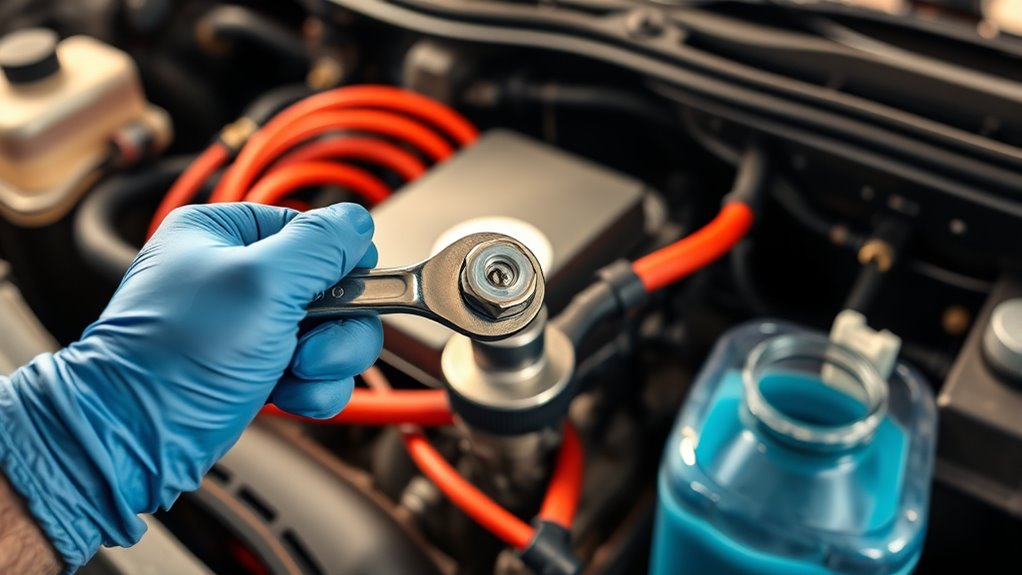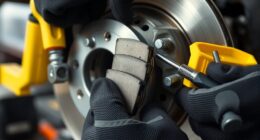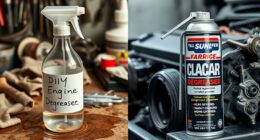To flush and refill your coolant system, start by ensuring your engine is completely cool, then locate the radiator drain plug and drain the old coolant into a safe container. Fill the system with a flush solution or water, run the engine for about 10 minutes, then shut it off and let it cool. Drain the flush, then refill with a proper coolant mixture, bleeding trapped air as needed. For detailed steps, continuing will guide you through each stage successfully.
Key Takeaways
- Ensure the engine is cool, then locate the radiator drain plug and drain old coolant into a suitable container.
- Fill the radiator with flush solution or water, start the engine, and run for about 10 minutes to loosen deposits.
- Turn off the engine, let it cool completely, then drain the flush solution or water from the system.
- Refill with a proper coolant mixture, open bleed valves to release trapped air, and monitor for leaks or overheating.
- Once cooled, check coolant levels, top off if necessary, and inspect the system regularly for leaks or issues.

Flushing and refilling your coolant system is an essential maintenance task that helps keep your vehicle running smoothly and prevents overheating. Over time, coolant can become contaminated or lose its effectiveness, leading to issues like engine overheating or coolant leaks. Addressing these problems promptly ensures your vehicle stays reliable. Before starting, make sure your engine is cool to avoid burns or injury. If you notice a coolant leak or your heater isn’t working correctly, it might be time for a coolant flush or thermostat replacement. Ignoring these signs can lead to more severe engine damage down the line.
Begin by safely draining the old coolant. Locate the radiator drain plug underneath your vehicle and place a container underneath to catch the fluid. Open the drain plug and let the coolant flow out completely. Be cautious—coolant is toxic and should be handled with care. Once drained, close the drain plug tightly. To thoroughly flush the system, fill the radiator with a radiator flush solution or plain water, then start your engine and let it run for about 10 minutes. This process helps break down deposits and flush out any remaining contaminants. Turn off the engine and let it cool completely, then drain the flush solution or water as you did with the old coolant. Using natural materials like wood or stone in your garage or workspace can help create a safer environment when working on your vehicle.
Safely drain old coolant, then flush with water or radiator solution to remove deposits and contaminants.
Next, it’s time to refill the system with fresh coolant. Mix the coolant with distilled water if required, following the manufacturer’s recommended ratio. Pour the mixture into the radiator or coolant reservoir, opening any bleed valves to release trapped air. Air pockets can cause hot spots or overheating, so ensure all air is expelled. Keep an eye on the temperature gauge as you start the engine again, watching for signs of overheating or leaks. If you notice coolant leaking or the temperature rising unexpectedly, it could indicate a coolant leak or that your thermostat needs replacement. Replacing a faulty thermostat ensures proper coolant flow, preventing overheating and maintaining engine temperature.
Finally, check the coolant level once the engine cools down. Top off if necessary, ensuring the system is filled to the recommended level. Regularly inspecting your coolant system can help you catch issues early, saving you money and preventing breakdowns. Remember, a well-maintained coolant system is crucial for your engine’s health, especially if you’re experiencing persistent coolant leaks or temperature fluctuations. By following these steps and addressing problems promptly, you’ll keep your vehicle running efficiently and extend its lifespan. Proper maintenance not only prevents costly repairs but also ensures your driving experience stays safe and smooth.
Frequently Asked Questions
How Often Should I Flush My Coolant System?
You should flush your coolant system every 30,000 to 50,000 miles or every 2 to 3 years, whichever comes first. Regular radiator maintenance helps prevent overheating and corrosion. When you flush, make sure to properly dispose of the old coolant, as coolant disposal is essential for environmental safety. Keeping up with this schedule ensures your cooling system stays efficient and your engine runs smoothly.
Can I Use Any Type of Coolant?
Imagine your radiator as a vital river, and the coolant as its life-giving water. You can’t just use any coolant for radiator maintenance; stick with the specific coolant types recommended by your vehicle manufacturer. Using the wrong coolant can cause corrosion or damage. Always check your owner’s manual to verify you’re choosing the right coolant type, guaranteeing your cooling system runs smoothly and efficiently.
What Are Signs of a Coolant System Problem?
You’ll notice signs of a coolant system problem if you see coolant leaks under your vehicle or if the engine starts overheating frequently. Overheating issues can also cause your heater to blow warm air or the temperature gauge to read high. Pay attention to sweet smells or steam coming from the engine area, as these indicate coolant loss or leaks. Addressing these signs promptly can prevent more serious engine damage.
Is It Necessary to Replace the Radiator Cap?
Think of the radiator cap as the gatekeeper of your coolant system‘s pressure. It’s crucial to replace it if it’s worn or damaged, because a faulty cap can’t maintain proper pressure, leading to overheating. Regular radiator cap maintenance ensures your coolant system stays sealed tight, preventing leaks and pressure loss. Don’t ignore it—upgrading your radiator cap keeps your engine running smoothly and avoids costly repairs.
Can I Flush My Coolant System Myself?
Yes, you can definitely do a DIY maintenance on your coolant system. Start by draining the old coolant, then flush the system with water or a radiator cleaner. Make sure you’re aware of different coolant types, like ethylene glycol or propylene glycol, to choose the right one for refilling. Follow proper safety precautions, and you’ll keep your cooling system running smoothly without needing a mechanic.
Conclusion
Remember, a well-maintained coolant system keeps your engine running smoothly. Regular flushing and refilling prevent costly repairs and guarantee your vehicle stays reliable. Don’t wait until it’s too late—”An ounce of prevention is worth a pound of cure.” By taking care of your cooling system now, you’re protecting your investment and driving with peace of mind. Stay proactive, and your engine will thank you every mile of the way.









